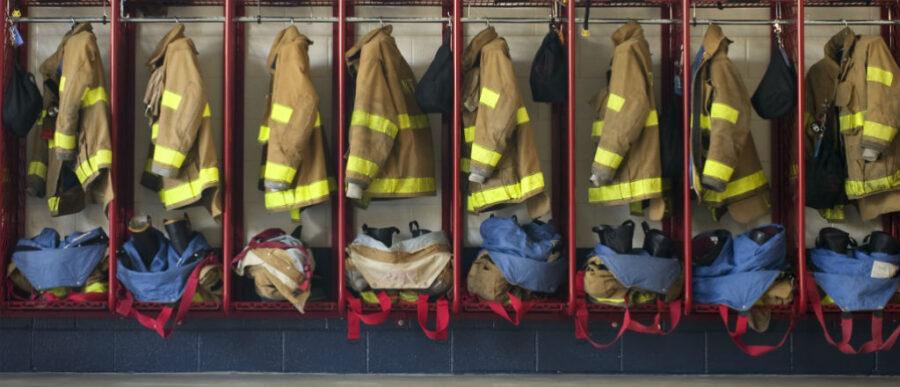The Beatles famously sang that “all you need is love,” but a new study by Wharton management professor Nancy Rothbard finds that maybe love alone isn’t enough in the workplace. Her latest research paper, “Is Love All You Need? The Effects of Emotional Culture, Suppression, and Work–family Conflict on Firefighter Risk-taking and Health,” published in the Academy of Management Journal, examines the role of emotion in majority-male organizations. Rothbard and co-author Olivia Amanda O’Neill, a management professor at George Mason University, conducted a qualitative study of fire stations in metropolitan areas to find that the most fulfilling workplaces are both compassionate and convivial. Rothbard spoke to Knowledge at Wharton about her research.
An edited transcript of the conversation follows.
Knowledge at Wharton: Your study focused on an interesting environment, which was firehouses and firemen. Why did you pick firemen? What you were looking at, and what you were trying to find?
Nancy Rothbard: Mandy and I really wanted to go in and understand how the emotional culture of an organization could affect how people both interact in the workplace, but also what the effects on them physiologically might be. We were really interested in looking at emotional culture, in particular the culture of love, as well as another particular type of culture that often emerges in organizations, especially masculine organizations, which is called “culture of joviality.” A culture of joviality is sort of the fun, the joking, the pranks, kind of a macho, back slapping, teasing type of a culture. A culture of companionate love is really one where there is a sense of compassion, caring and affection for one another.
What was interesting about looking at this question in the context of firefighters is that this is a really extreme setting to think about the question of love. There’s a little bit of past research that’s looked at a culture of companionate love, and that has looked at mostly health care settings and other kinds of organizational settings where it might be more expected, whereas we really wanted to look at an extreme case to see whether love matters and is love evident in these masculine organizations?
Knowledge at Wharton: What you found is that love does matter, but some other things matter, too. Tell us about some of the work that you did, which involved going into firehouses and talking to these people.
“There was something about being in a culture where you were able to both joke around but also get the feelings of compassion and caring … that really tempered each other.”
Rothbard: This paper comprises two studies. The first was a qualitative study where we did interviews with 27 different groups of firefighters…. We went in and wanted to [ask] questions about culture, but also what made their jobs tough or what were the challenges they were facing in their jobs. There were a couple of really interesting things that emerged from that stage of the research. One is that when we asked people [what is] the toughest thing about their job, the answer they gave was surprising. We interviewed 100 people in this first study, and 97 of them were men. There were three women in the entire group, and that’s very prototypical and expected in firefighting occupations. When we asked, “What’s the most challenging thing about your job?” over half of them said work-family conflict, which was a huge surprise to us. We were not expecting that to be the answer. It makes a lot of sense in retrospect, because their jobs are really affected by the type of shift work that they do, and the type of work that they do is often very emotionally stressful.
Interestingly, most of their job is not fighting fires. Most of it is emergency response. Any time 911 is called, firefighters have to respond, so they are at the scenes of all sorts of emergency calls and situations. Some of them are more stressful than others. What we found when we were talking to them was they were really concerned about some of the stresses that they experienced on the job spilling over to the home.
One story that really sticks in my mind from this first study was of one of the firefighters who described how he really wanted to keep the workplace separate from his home life, so he kept a pair of flip-flops in the station and would wear those back and forth between his home and work because he didn’t want his boots that he wore on the scene to even enter his house. He felt like he didn’t want the work to contaminate his home. He had a very extreme example of trying to keep these two apart.
A lot of the other things that we talked about with the firefighters also had to do with the culture of their station and of the firehouse. One of the themes that emerged was this culture of joviality that we expected — the pranks, the humor, all of the kind of fun things that they do to keep themselves occupied and to relieve the stress. But the second emotional theme that emerged around culture was this theme of companionate love. Another way to think about companionate love is brotherly love. It’s not romantic love; it’s giving each other a hug if something tough has come up, making sure that you are there for each other, that you know each other deeply and show that you care about one another. Sometimes, that can be in small acts, like washing the dishes or making sure that you have somebody’s favorite snack in the kitchen. There’s a lot of camaraderie and brotherly love that we also saw at some of these fire stations.
What’s really interesting about this study to me is that we looked at firefighters as an extreme case of masculine organizations, but this really can apply to lots of different organizations. It can apply to all sorts of settings where the norms are really masculine in terms of the dominant expected behavior. We see all sorts of examples of that kind of camaraderie — the frat house culture, on Wall Street — just as we do in the firehouse or in police stations or in [military] settings. It might be a little bit easier to see the connection with firefighters, but we see these same types of behaviors in lots of different occupational settings.
Knowledge at Wharton: Tell us about the second part of the study and where you went from there.
Rothbard: In the first part of the study, we did these interviews and had a couple of surprises that arose along the way. One of the other pieces that we saw there was that one of the ways that firefighters talked about coping with some of these stresses was through suppression, kind of bottling it up and keeping it all in, or separating it as I talked about before. But what the literature says about suppression is that it’s often a very bad thing that can lead to all sorts of negative health outcomes and other problematic outcomes on things like risk-taking. We wanted to think about how do all of these things go together?
So, we did a second study where we surveyed a lot more folks. In the second study, we had 68 fire stations and we surveyed about 600 people. For a lot of folks that we surveyed, we also then surveyed their supervisors. We asked the battalion chief, “What’s the culture of the station? Do you see it being characterized by joviality? By these jokes, these pranks, the teasing, the amusement? Do you see it being characterized by compassion, by tenderness, by love?” They could have answered both, and indeed in our interviews we found that there were some stations that were characterized by both. There were some stations that were characterized by either just joviality alone, and there were others that were characterized by just love alone. And some exhibited neither of those characteristics.
“There’s a lot of camaraderie and brotherly love that we saw at some of these fire stations.”
We got about 324 participants who responded. When people said that they felt like they experienced a lot of work-family conflict, and they were also suppressing that conflict, it turns out that was kind of a bad thing, as the literature would suggest. In fact, we found that those folks engaged in more risk-taking off the job. They reported more alcohol use, high-risk types of hobbies, etc. But when people were in cultures that the battalion chiefs had rated as being high in both joviality and companionate love, risk-taking was reduced. There was something about being in a culture where you were able to both joke around but also get the feelings of compassion and caring, of brotherly love from your fellow firefighters, that really tempered each other and allowed people to vent a little in the workplace so that they didn’t have to let off that steam outside of work.
Knowledge at Wharton: This study looks very closely at these organizational cultures at firehouses. How can someone apply this at their office? Sometimes it is very hard to know what your organizational culture is because you have to be pretty honest with yourself, especially if you’re the manager and the one who is modeling this.
“It’s not romantic love; it’s giving each other a hug if something tough has come up, making sure that you are there for each other, that you know each other deeply and show that you care about one another.”
Rothbard: It’s fairly straightforward to diagnose your culture. First of all, you have to be willing to look and be open to what you find. When you think about emotional culture, there are signs all around us. There are artifacts, statements, stories that people [tell] that you can use to really diagnose [culture] and understand it. With culture and joviality, the thing that you want to look for as a manager is, is it going too far? The teasing and the pranks may be a very fun, high energy, high octane, but is that going too far? That’s the thing you worry about with a culture of joviality, right? Is it crossing the line to bullying or harassment? That’s what you don’t want as a manager.
With culture of companionate love, what you want to look for are things like, are people caring about each other? Are they checking in when somebody is sick? Are they making sure that they know how things are going with a particular individual? As a manager, you can model that behavior. If your employee is out sick for a couple of days, you can send them a note or give them a phone call and say, “Hey, just thinking of you. How are you doing? Is there anything I can do to help?” Those kinds of things really help to model a culture of love where people feel like others are looking out for them, that they care about them and that they matter in that organization. I think it’s not as hard as it might seem to model those things and to check to see whether you have a culture of joviality in addition to a culture of love.
Knowledge at Wharton: This study seems to debunk some of the stereotypes that we may have about male-dominated workplaces in that you found lots of companionate love or brotherhood that was going on. We may stereotype that it’s something you would find more with female-dominated work places.
“The teasing and the pranks may be a very fun, high energy, high octane, but is that going too far?”
Rothbard: Absolutely. One of the things that we found that was really fascinating in this setting is that when we looked at culture of love, this was not something that we had necessarily gone in expecting to see. What was fascinating about it to us is that it really did appear very strongly in the setting. When we think about masculine organizations, a lot of times we think these are organizations where it’s not OK to express any emotion, much less love. Yet we saw all sorts of emotional expression going on, including love.
Knowledge at Wharton: How do you plan on following up this research?
Rothbard: My co-author, Mandy, has a study where she’s looking at different emotional cultures in a hospital setting, and I think it’s going to be really fascinating. For me, one of the things that was really interesting about this is this piece where work-family conflict just seemed to emerge almost out of nowhere in these masculine organizations. That’s something that really hasn’t been looked at in the literature as much. When we talk about work-family conflict, we tend to think about women experiencing work-family conflict. But focusing on men and the fact that men experience work-family conflict just as powerfully is a really important finding that we saw here, which I really want to explore further in future research.



